Through the Land of a Thousand Lakes
RAILWAYS OF EUROPE - 19
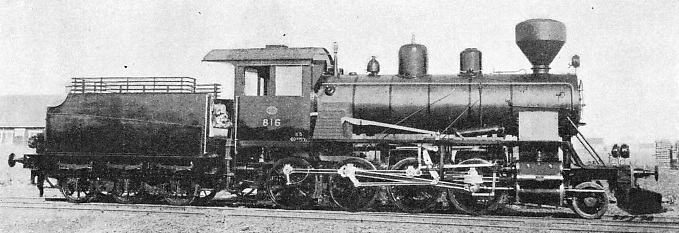
WOOD-BURNING ENGINES form a large proportion of the locomotives owned by the Finnish State Railways. The 2-8-0 engine above is one of Class K5 built at Tampere in 1928. Woodburners are used on local and up-country lines.
TO many people, Finland may seem a very remote country, hidden beyond Scandinavia and crouching under the wing of European Russia. In a sense it is remote, though less so than the uninformed may imagine. The cities of Hanko and Turku or Abo (pronounced as “Oboe”) are within a night’s journey from Stockholm, Viipuri (Viborg) is close to the Russian frontier at the other southern corner of the country, and the capital, Helsinki (Helsingfors), is situated roughly halfway between. Opinions are only half-formed, as a rule, on the nature of the country, as well as on its situation. Readers may imagine a region of polar desolation, a land of perpetual ice and snow, peopled by a few dusky Laplanders, with bears and other northern wild animals for their sole companions. This certainly applies to the distant northern regions, but so it does to the north of Sweden, Norway, and Russia.
For the most part, Finland is flat, except in the north-east, where it marches with the main Scandinavian system of mountains. The greater part of the country is covered by primeval forests, but nearly eleven per cent of the total area is covered by water, thus giving the country its appropriate and beautiful name, “The Land of a Thousand Lakes”.
The whole country, with a total area of about 150,000 square miles, contains a little over 3,400 miles of railway route,
of which by far the greater part is owned and worked by the State. Naturally, in a country such as Finland, a dense railway system is not expected; the mileage just quoted is not quite half that of thickly populated little Belgium, a country less than a twelfth the size of Finland. But what it lacks in density, the Finland State railway system makes up in the length of some of its main lines, in this respect providing a parallel in miniature to Canada, a country whose transcontinental routes are famous.
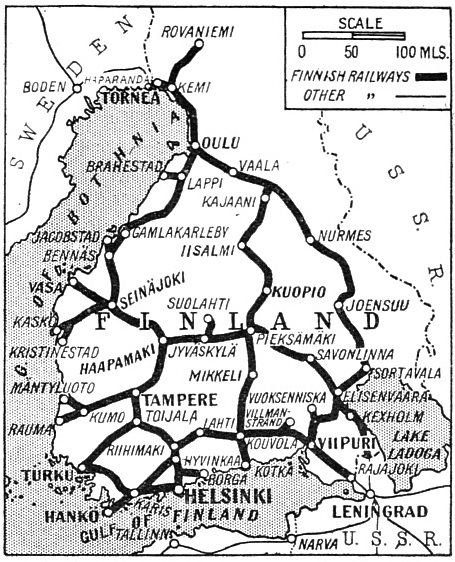
THE FINNISH STATE RAILWAYS, formerly a part of the Russian system, operate to-day 3,400 miles of 5 ft gauge track. There are also a number of privately-owned narrow-gauge lines.
Right across hundreds of miles of Finland’s almost unpopulated woodlands lie the thin steel lines of her railway tracks, connecting widely separated towns, and providing for the country’s trade and communications. Carrying the track through the forests was a comparatively easy matter during the summer months, when the weather was kindly and darkness non-existent. On the other hand, Finland, in company with parts of Sweden, abounds in short but wide and turbulent rivers, through which the waters from her thousand lakes find their level, and bridge construction was often necessary on a heavy scale as the railways gradually extended.
A curious thing about the Finnish railway system, as with nearly all modern industrial developments in the country, is that the greater part of it grew up under foreign domination. From 1809 to the end of 1917, Finland was a Grand Duchy of the former Russian Empire. She was not independent until the institution of the Soviet regime in Russia. For all that, the country retained greater independence under Russian rule than such countries as Estonia and Latvia, and this has always been reflected in the general features, and especially in the quality of her railway system.
The pre-war Russian railway system, as explained in the chapter beginning on page 1004, was undeveloped, with primitive signalling arrangements in many places, poor permanent way, and uncertain, badly-lighted trains. The Russian lines were built to the 5 ft gauge, slightly broader than the standard European gauge, and so pre-war Finland, as a Russian Grand Duchy, also had her railways developed on the broad gauge to be in line with the rest of the Russian Empire. But from quite early days, the Finnish railways had marked characteristics which made them easily distinguishable from the systems of Russia proper. The first line in the country was opened from Tavastehus to Helsingfors - as it then was - in 1862. Under the last of the Tsars, the Finnish State Railways had developed into a curious mixture of Russian and Swedish practice. This was due to the fact that throughout modern times the population of Finland contained a large proportion of Swedes, who, with the Finns themselves, clearly did more to influence railway development than the Russians.
The design of Finnish locomotives and coaches, though influenced by the wider rail and construction gauges of Russia, has always been reminiscent of Scandinavian practice. Even in the days when the purely Russian idea of signalling was a lamp or a basket-work ball hauled to the top of a pole by a pulley, Finland had all her important stations signalled on an efficient western plan, similar to those of Sweden and Germany. The administration of the Finnish State Railways, or Valtionrautatiet as it is called, has its headquarters in Helsinki, and operates about ninety-six per cent of the total railway mileage in the country, including, of course, all the most important main and branch lines. In contrast to those of most European countries, Finland’s railways are principally of inland significance. While a certain amount of Finnish-Swedish traffic passes over her lines, the only line having through international trains is that running eastwards out of Helsinki.
An International Route
The first part of this route runs concurrently with the main line to the Far North for forty-four miles, as far as the junction station of Riihimaki. Thence it veers round towards its ultimate destination, and - after skirting the extreme southern shores of Lake Paijanne - reaches the town of Lahti. Thence a small private railway strikes southwards to the sea coast at Lovisa. Continuing eastwards, the main line crosses the Kymmen River before reaching Kouvola. This is the most important junction the line has served since Riihimaki; a branch runs southwards, bifurcating in its turn to serve the coast towns of Kotka and Frederikshamn, while a long main line strikes northwards into the interior of the country. Continuing through Luumaki and Simola, and crossing the wide Viipuri River on a fine bridge, the city of Viipuri (Viborg) is reached, 194½ miles from Helsinki. Viipuri is an important junction, besides being a most interesting city and an active centre of export trade. The ocean-going steamships come up the wide river mouth from the Baltic. The international line bears south-east through Raivola to the frontier station at Rajajoki, opposite the Russian fortress island of Kronstadt and quite close to Leningrad. This line was opened throughout in 1870. An alternative loop-line runs between Viipuri and the frontier, all along the coast, giving splendid views of the sea approach to the old capital of Imperial Russia.
A line runs northwards out of Viipuri, and this, with its various branches, forms an excellent means of access to the beauties of the “Thousand Lakes”, the world-famous Imatra Rapids, and the wild northern forests. In that well-watered country may be seen numerous fine steel bridges and viaducts, rivalling in size and number those of many countries much larger than Finland. For the moment, however, we are concerned with Finland’s other international railway connexion.
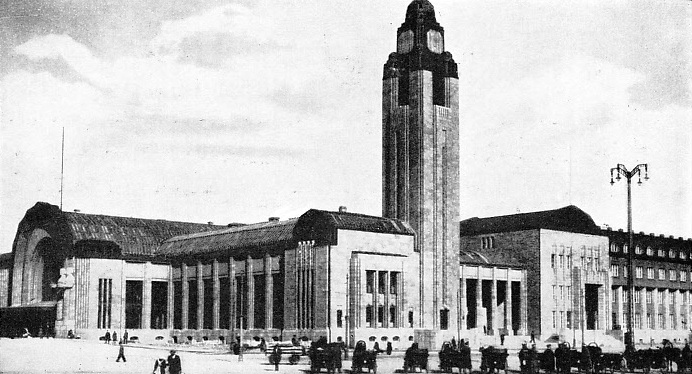
AT HELSINKI. The Central Railway Station of the Finnish capital. The pioneer line in Finland was opened between this city and Tavastehus in 1862. To-day the railway administration has its headquarters at Helsinki.
Returning to Helsinki, we find that there are two easy ways of communicating with Sweden and Scandinavia generally via Stockholm. One of these is by sea throughout, and does not concern us in the present instance. The second is the railway line running westwards. This splits in two at Karis, one line running to Hanko and the other to Turku (Abo), eighty-five and 124 miles respectively from Helsinki. From either of these places there is a convenient steamer service to Stockholm. From Karis, too, a connecting line runs up to Hyvinkaa, near Riihimaki, thus providing a through route from Central Finland to Hanko, which avoids Helsinki altogether. Through trains connect Hyvinkaa with Hanko, the distance being only ninety-three miles, while Turku is served by through trains from Helsinki.
Finland’s third international railway connexion begins at Tornea in the far north, opposite to the Swedish town of Haparanda, on the other side of the river. Through trains are run by the Swedish State Railways from Stockholm to Haparanda, and the Finnish State Railways run through trains southwards again from Tornea to Helsinki, but through running between the two railway systems is out of the question, because of the break of gauge; Sweden using the standard 4 ft 8½-in gauge. But unless they were very bad sailors, people would hardly travel from Stockholm to Helsinki via Tornea. Such a journey would last nearly forty-eight hours, whereas the sea route or sea and rail route via Turku provides a simple and comfortable overnight journey.
Locomotive Shops
Tornea is a valuable interchange point for traffic coming from northern Scandinavia, and there are few more striking railway journeys than that from the Norwegian port of Narvik, north of the Arctic Circle, across the mountains into Sweden and down to Haparanda, followed by the Finnish run down through the lakes and forests to Helsinki.
Southwards from Tornea to Oulu (Uleaborg), the main line runs along the tideless coast of the Gulf of Bothnia for eighty-two miles, one branch striking upwards from it to Rovaniemi on the Arctic Circle. The line then splits into two, one branch running south-west and the other south-east into the Finnish Lake District. The branch running south-west touches the coast again at Gamla Karleby, and skirts it to Ny Karleby. At the southern end of the great lake of Nasi Jarvi, two arms of which are crossed by the railway, the important centre of Tampere or Tammerfors is reached. Tampere is a large industrial town, as well as being a good tourist centre. Many of the Finnish State Railway’s most modern locomotives have been built there. At the junction of Seinajoki, on the way south from Ny Karleby, two important branch lines join the main line, one from Kristinestad and the other from Vasa. Both these towns owe their names to the old time of Swedish imperial domination, the former being named after the great Queen Christina, while the latter bears the name of Sweden’s most famous royal house. Finnish national pride, on the other hand, is nurtured by the town of Tavastehus, roughly half-way between Tampere and Helsinki, for this was the birthplace of the composer Sibelius. Railways and music seem to go together, sometimes. The great Czech composer Dvorak used to get angry with his pupils if they could not tell him the number of the locomotive which had brought them up to town. The north-to-south main line joins that from Leningrad and Viipuri at Riihimaki, together with a branch from Lappi on the west side. The total distance from Tornea to Helsinki is 550 miles, via Seinajoki, and the journey takes nearly twenty-three hours.
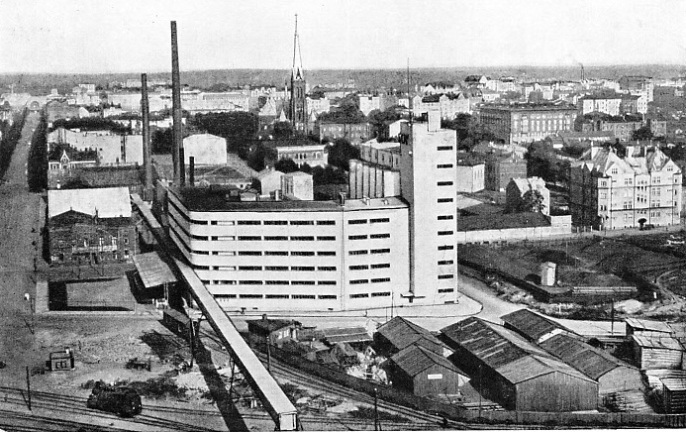
A GENERAL VIEW OF VIIPURI, showing the railway in the foreground. A branch line can be seen leading to a large flour mill. Viipuri is a big industrial city and a port. By rail, it is 194½ miles from Helsinki.
The eastern line from Oulu follows the River Ulea to its source in the lake called Ulea Jarvi, which it skirts to Kajaani, From a junction just before this city, a long connecting line runs down parallel to the Russian frontier, joining the south coast main line at Viipuri after running along one side of the vast Lake Ladoga, which, with its area of 7,000 square miles, is the largest lake in Europe. The Russo-Finnish frontier runs right across Lake Ladoga. Returning to Kajaani, we follow the alternative main line between the Far North and Helsinki to Iisalmi, where a cross-country line links up with the western line at Ylivieska, between Oulu and Gamla Karleby. The main line then runs south through the lake district to Kuopio, the capital of the province, of that name, then through Mikkeli, another provincial capital, to Kouvola, between Viipuri and Helsinki.
Finnish locomotives are large, but not particularly heavy. The Finnish construction gauge, as already mentioned, enables locomotives, coaches and wagons to be built to much more generous dimensions than is possible in Great Britain. As in Russia, there are quite large engines carrying relatively tall chimneys and domes, and high, wide cabs. There is no reason for cramping the cylinders and motion, and inside-cylinder engines, though not unknown, are rare. All modem Finnish locomotives have outside cylinders and valve gear. But in the face of these generous allowances in the matter of dimensions, really heavy locomotives are not necessary. It would be possible to build engines rivalling in size those of the USA, but Finland is sparsely populated, and the loads are comparatively light. Similarly, with the freight trains, there is little heavy traffic in coal and minerals, while the immensely long cattle and grain trains which, in America, travel from the Middle-West to the Atlantic Coast, have no counterpart in the Land of a Thousand Lakes.
Engines in Finland
Again, Finland has no long express passenger trains corresponding to the British “Flying Scotsman”, “Royal Scot”, “Cornish Riviera Limited”, or “Atlantic Coast Express”. Nor are there any long freight trains such as the LMS handles with its big “Garratt” engines. So while a Finnish locomotive, were it set down in Great Britain, would look immensely tall and wide, neither it nor any of its fellows would equal in weight and power the “Flying Scotsman” or “Cock o’ the North”, let alone the “Garratt” goods engines. Finland has no need as yet for giant locomotives, even by British standards. But she has many fine modem machines which would do credit to any country.
The Finnish State Railways, in the same way as many foreign lines, were early users of British-built locomotives. Before the war of 1914-18, considerable numbers of engines were built for them in the United States by Baldwins, of Philadelphia, and the Richmond Locomotive Works, of Richmond, Virginia. Three 0-6-0 goods engines, built by Neilson and Co, of Glasgow, as far back as 1869, were still in service in 1927, if not later, while there were ten more, dating from 1869 to 1874, built by the Avonside Engine Company at Bristol. Between 1895 and 1898, eleven 4-4-0 express passenger locomotives were built by Dubs and Co, of Glasgow, while in the last-named year three similar engines were built by the Swiss Locomotive Works. The earliest bogie express engines were of the same general type, but were built by Sigl of Vienna as far back as 1875-6.
In the early part of the present century, and also in the last years of the nineteenth century, large numbers of “Mogul”, or 2-6-0 goods and mixed-traffic engines, were built by various firms. Some were constructed in the State Railways’ own workshops. The earliest of these, dating from 1888, were the first locomotives to be built in Finland.
Many Finnish locomotives are reminiscent, in appearance, of those of early America. This is due to the enormous spark-arresting chimneys with which the wood-burning examples are equipped. As Finland possesses inestimable wealth in the shape of timber, it is not unnatural that many of her locomotives should burn wood. The wood-burner is not speedy, but it is well suited to rural goods traffic, and to all kinds of work on the long up-country branches. Some of the most modern Finnish locomotives are built to bum wood, and they present a striking appearance to the uninitiated, with clouds of clean-smelling wood-smoke coming from their great “balloon stacks”, and with their short, square tenders piled high with hundreds of pine logs.
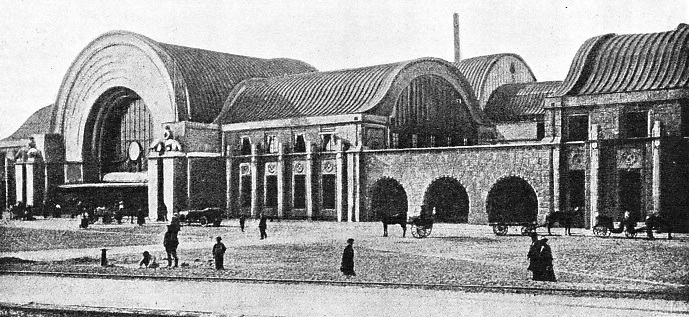
COMPLETED IN 1913, the Railway Station at Viipuri was designed by one of Finland’s leading architects. The first through line connecting Finland with Russia was laid through Viipuri and ran to St. Petersburg, now Leningrad. Viipuri is an important junction.
The modern standard Finnish express engine is of the 4-6-0 type, weighing, with tender, in working order, approximately 100 tons. These are known as Class H 9, H being the class letter of all the Finland State 4-6-0’s. They are intended to maintain a maximum speed of fifty miles an hour with trains of about 400 tons. This sounds low, but it must be remembered that on the majority of Finnish lines, trains are necessarily few and far between, and even the “expresses” have to call at every station of any importance, reducing the journey speed very considerably, and putting an additional tax on the locomotive power.
These H 9 4-6-0 locomotives are straightforward machines of the two-cylinder simple type, and are well chosen for dealing with all kinds of passenger traffic. To those who prefer “outlines” to “streamlines”, they are quite handsome engines, combining the style of the average Swedish design with the proportions of a Russian engine. Because of the long stretches through wild forest land, cowcatchers are invariably fitted, while an ingenious mechanical bell is also installed on each engine.
Finland has a most formidable winter climate, with deep falls of snow. Small snow-plough shields are therefore fitted over the cowcatchers to supplement the work done by the special snow- ploughing engines. Powerful acetylene headlights are mounted in front, contrasting with the great oil lamps which are still found on the majority of the neighbouring Russian locomotives. The compressed gas is contained in a cylinder on the main frames.
Finnish Locomotive Types
The most modern goods locomotives are of the 2-8-0 type, belonging to Series K, some burning coal and others burning wood. They vary in size. A Class K 4 engine has a weight, with tender, in working order, of 110 tons. There are twenty locomotives of this class, built by the American Locomotive Company. Class K 5 is similar, but smaller, being designed for the lightly laid lumber lines of the interior. These engines are wood-burners, with high-sided six-wheeled tenders, whereas those of Class K 4 and some of the H 9 4-6-0’s have eight-wheeled bogie tenders. Many of these light 2-8-0’s have been built during the past few years, as they provide a more powerful unit than the old “Moguls”, while they are equally well suited to a track of light construction, for in spite of their tough appearance, they weigh only 78 tons apiece.
Two fine tank engine designs have appeared in recent years, one for heavy short-distance passenger work, and the other for shunting, marshalling, and local goods traffic. In outline they are similar, and they are, perhaps, the neatest looking engines in the country. The passenger engines are of the 2-8-2 type, and belong to Class N 1, Their weight in working order is about 88 tons; they are well fitted for service on trains of frequent stops, which entail rapid acceleration with a heavy load. The first of these were built in Germany, by the Hanover Engine Company (“Hanomag”) of Hanover-Linden, while succeeding examples were turned out from Finnish workshops.
The second modern tank engine class, known as Class O 1, are of the 0-10-0 type, and have the same origins as the
2-8-2’s. Their boilers, cylinders, and motion are interchangeable, and the two classes form an interesting example of standardization. The ten-coupled engines each weigh approximately 78 tons in working order, and are designed to haul loads of 900 tons. The eight-coupled passenger engines have a permitted load limit of 720 tons, which is much in advance of the capabilities of the 4-6-0 locomotives.
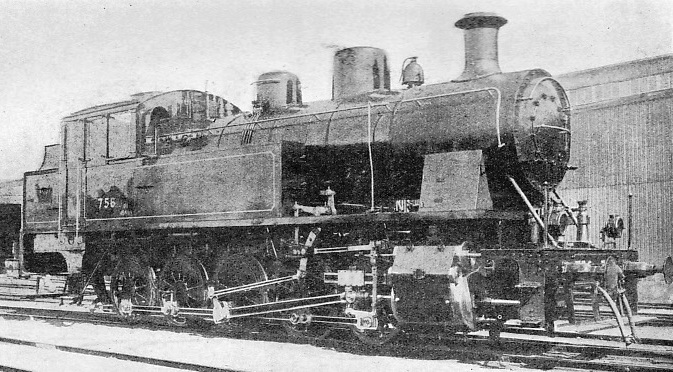
TEN-COUPLED TANK LOCOMOTIVE, Class O 1, of the Finnish State Railways, designed for heavy shunting and local goods traffic. The engines in this class weigh, approximately 78 tons in working order, and were built to haul loads of 900 tons.
Travel in Finland is slow, but it is comfortable, and the fares are reasonable. Passenger coaches are of the centre-corridor type, except for sleeping cars, and in the normal way two classes of passenger are provided for, second and third. The second-class cars somewhat resemble third-class Pullmans in Great Britain, but they are much more spacious and have high domed or, very occasionally, clerestory roofs. The passengers sit four a side, two on either side of the central gangway, in comfortable armchair seats, well upholstered in grey velvet. The gangways are wide. The third-class cars are similar to the second, except that they are plainly furnished, as is usual on the European mainland. For all that, they are roomy and clean. Travel in them for a few hours, especially if the passenger takes a folded rug or an air-cushion to sit on, is by no means uncomfortable. In any event, anyone desirous of studying the characteristics of the Finnish people on the railway should travel third-class. That might be said of any country, but he is a brave man who voluntarily travels third on some Continental railways, especially in Eastern Europe.
First-class accommodation on the Finnish railways is rare. True, the passenger can buy a first-class ticket, if he chooses to pay double the second-class fare, and when he enters his carriage he will find it sacred to the holders of tickets such as his own. But the vehicle itself is almost bound to be of the same type as the second-class next door, In the sleeping cars, however, there is some object in travelling first-class, for, as in Great Britain and some other countries, a first-class ticket reserves a whole sleeping compartment. Second-class Sleepers have two-berths compartments. First-class accommodation is advertised as available on the special express trains between Helsinki and Viipuri, which carry through cars for Leningrad; otherwise it is sought for in vain. As a rule, a single sleeping car provides the through connecting link with the former Russian capital.
Mention has already been made of the big bridge which carries the line across - the river just to the west of Viipuri, but there are many other fine structures in various parts of the country; far too many, in fact, for enumeration.
Privately-Owned Lines
The River Kymimis is crossed by an extremely remarkable lattice girder structure consisting of one long span over the stream itself, approached by two smaller spans; while relatively close, at Antrea, there is another fine bridge spanning the river some way below the famed Imatra Rapids.
Though the volume of passenger traffic is small, the Finnish railway stations are well worthy of commendation. The Central Station at Helsinki, with its great main hall, tower, and the colossal figures flanking the main entrance, is one of the show stations of Europe. Generally speaking, the railways of Finland have an exceptionally good record for safety. Incidents are rare and accidents rarer.
Finland has only five privately-owned railways. Three of these, which have their own rolling stock, are built to the narrow
2 ft 6-in gauge. This is in contrast to the neighbouring country of Sweden, where the State works few beyond the principal main lines, and the country abounds in privately-owned railways of every description. The largest Finnish private line is the Lovisa-Wesijarvi Railway, mentioned in passing when the line from Helsinki to Viipuri was described. It has a total route length of roughly fifty miles, and is operated by eleven locomotives, eight carriages and 250 wagons.
Though there are no really fast trains in Finland, no giant locomotives handling freight traffic on a stupendous scale, no heavily graded mountain lines completed only after Herculean feats of perseverance, that strange and beautiful country certainly does contain one of the most interesting and most self-contained railway systems in Europe.
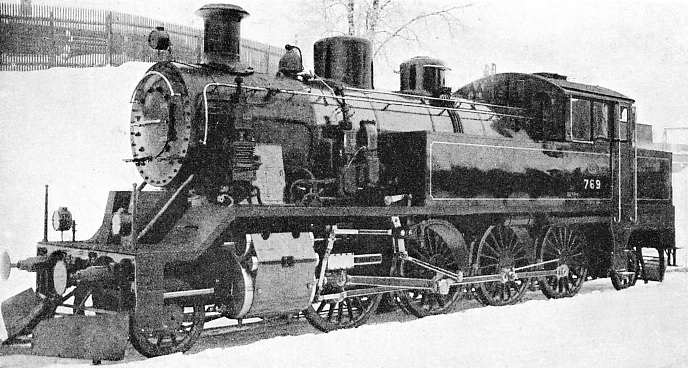
A “MIKADO” TANK ENGINE employed for passenger traffic on the lines of the Finnish State Railways radiating from Helsinki. The State Railways own about 750 locomotives, 9 rail motors, 1,480 coaches and 23,300 wagons.
You can read more on “The Railroads of Norway”, “Russia and Siberia” and “Sweden’s Rail System” on this website.
You can read more on “Lapland’s Arctic Railway” in Wonders of World Engineering









